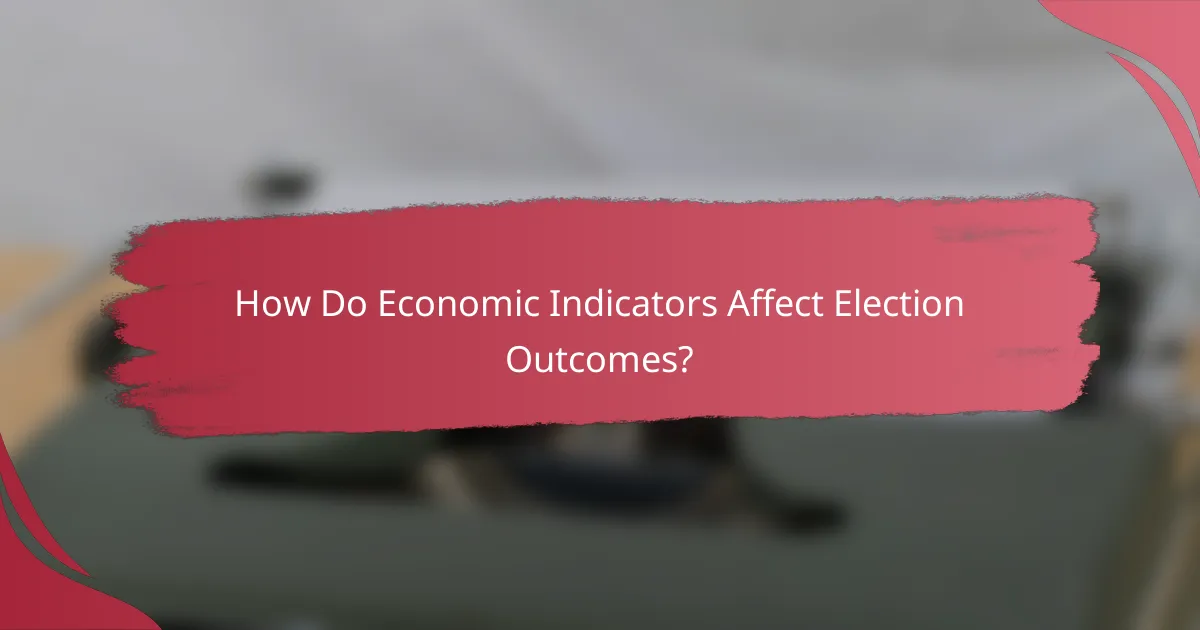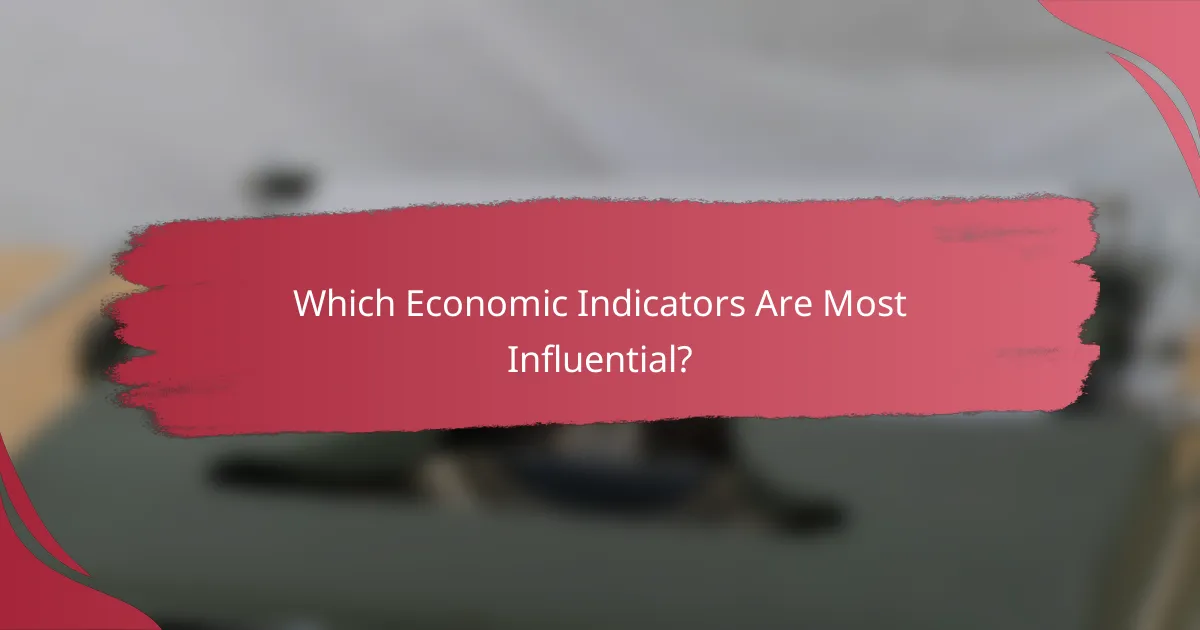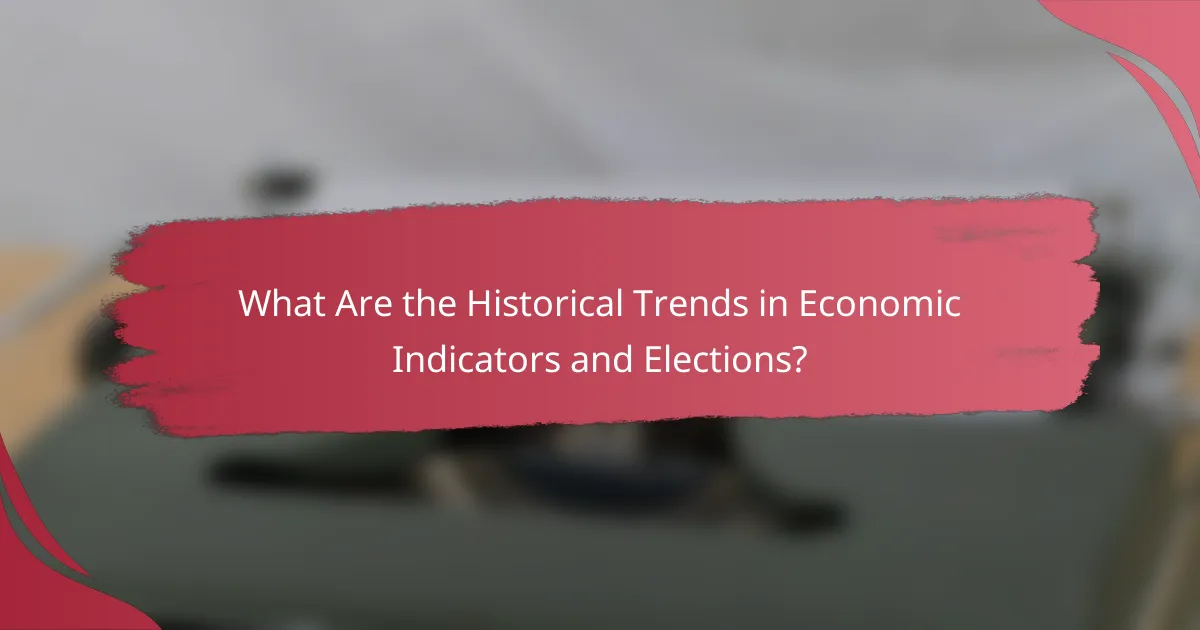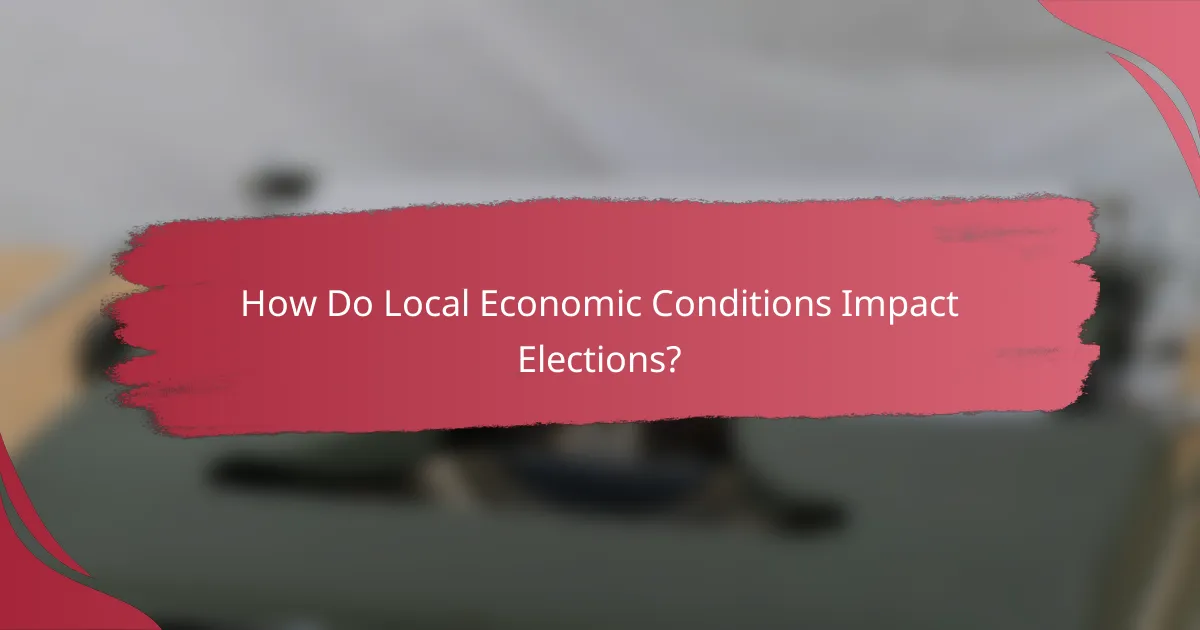Economic indicators play a crucial role in shaping election outcomes by influencing voter perceptions and priorities. Metrics such as GDP growth, unemployment rates, and inflation not only reflect the nation’s economic health but also guide voters’ decisions and candidate viability. By effectively leveraging these indicators in campaign strategies, candidates can resonate more deeply with the electorate’s concerns and aspirations.

How Do Economic Indicators Affect Election Outcomes?
Economic indicators significantly influence election outcomes by shaping voter perceptions and priorities. Factors such as GDP growth, unemployment rates, and inflation can sway public opinion and determine candidate viability.
Correlation between GDP and voting patterns
The Gross Domestic Product (GDP) is a key economic indicator that often correlates with voting behavior. When GDP is rising, incumbents typically enjoy higher approval ratings, as voters associate economic growth with effective governance.
Conversely, stagnant or declining GDP can lead to voter dissatisfaction and a shift towards opposition candidates. For example, during economic downturns, voters may prioritize change, favoring candidates who promise economic reform or recovery strategies.
Impact of unemployment rates on candidate popularity
Unemployment rates are a critical factor influencing candidate popularity. High unemployment often leads to frustration among voters, who may blame the ruling party for economic hardships. This discontent can drive voters to support challengers who advocate for job creation and economic revitalization.
In contrast, low unemployment rates generally bolster the popularity of incumbents, as they are perceived as successful in managing the economy. For instance, candidates in countries with unemployment below 5% often campaign on their economic successes, appealing to voters’ sense of stability.
Inflation rates and voter sentiment
Inflation rates directly affect voter sentiment and can sway election outcomes. Rising inflation typically erodes purchasing power, leading to public discontent and a demand for change. Voters may hold incumbents accountable for inflation, viewing it as a failure of economic management.
On the other hand, stable or low inflation can enhance voter confidence in the current administration. Candidates who effectively communicate their plans to manage inflation and maintain economic stability often gain an advantage in elections, especially in times of economic uncertainty.

Which Economic Indicators Are Most Influential?
Key economic indicators that significantly influence election outcomes include Gross Domestic Product (GDP), the unemployment rate, and the Consumer Confidence Index. These metrics provide insights into the economic health of a nation, shaping voter perceptions and decisions.
Gross Domestic Product (GDP)
Gross Domestic Product (GDP) measures the total economic output of a country and is a primary indicator of economic performance. A growing GDP often signals a healthy economy, which can lead to increased support for the incumbent party during elections.
Voters tend to favor candidates who can demonstrate strong economic growth. A GDP growth rate of around 2-3% is generally seen as healthy, while rates below 1% may raise concerns about economic stability.
Unemployment Rate
The unemployment rate reflects the percentage of the labor force that is jobless and actively seeking employment. A low unemployment rate typically correlates with a strong economy and can bolster the chances of the ruling party in elections.
For instance, an unemployment rate below 5% is often viewed positively, while rates above 7% may prompt voters to seek change. Candidates often highlight job creation as a key part of their platforms to appeal to voters concerned about employment.
Consumer Confidence Index
The Consumer Confidence Index (CCI) gauges how optimistic or pessimistic consumers feel about the economy’s current and future state. High consumer confidence usually indicates that people are willing to spend, which can stimulate economic growth and influence election outcomes.
A CCI score above 100 suggests a positive outlook, while scores below this threshold may indicate economic distress. Candidates can leverage consumer sentiment data to tailor their messages, focusing on economic recovery and stability to gain voter support.

How Can Candidates Leverage Economic Data?
Candidates can leverage economic data by integrating key economic indicators into their campaign strategies, which can enhance their appeal to voters. By presenting data that reflects the current economic climate, candidates can align their messages with the concerns and priorities of the electorate.
Using economic indicators in campaign messaging
Incorporating economic indicators into campaign messaging helps candidates resonate with voters’ experiences. For example, highlighting rising unemployment rates or inflation can evoke a sense of urgency and motivate action. Candidates should focus on relevant indicators such as GDP growth, wage trends, and consumer confidence to craft compelling narratives.
Effective messaging often includes specific data points that illustrate economic challenges or successes. For instance, a candidate might emphasize a decrease in local unemployment rates to showcase their impact on job creation. Using clear visuals like charts or infographics can also enhance understanding and retention of these messages.
Targeting demographics based on economic conditions
Targeting specific demographics based on economic conditions allows candidates to tailor their outreach effectively. For instance, candidates may focus on younger voters in areas with high student debt or older voters in regions facing healthcare costs. Understanding the economic landscape helps in crafting messages that address the unique concerns of these groups.
Campaigns can utilize data analytics to identify key demographics affected by economic trends. By segmenting voters based on income levels, employment status, or regional economic performance, candidates can design targeted advertisements and outreach efforts. This approach increases the likelihood of engagement and support from those most impacted by economic issues.

What Are the Historical Trends in Economic Indicators and Elections?
Historical trends show a significant correlation between economic indicators and election outcomes. Factors such as unemployment rates, GDP growth, and inflation often influence voter sentiment and can sway election results in favor of incumbents or challengers.
Case studies from past elections
In the 2008 U.S. presidential election, the financial crisis and rising unemployment rates played a crucial role in Barack Obama’s victory over John McCain. Voters were concerned about the economy, leading to a shift towards the candidate who promised change and economic recovery.
Similarly, in the 1992 election, Bill Clinton capitalized on a recession and high unemployment to defeat George H.W. Bush. Clinton’s focus on economic issues resonated with voters, demonstrating how economic conditions can dictate electoral success.
Analysis of economic data leading up to elections
Economic data such as consumer confidence, job growth, and inflation rates are critical indicators that can predict electoral outcomes. A strong economy typically favors the incumbent party, while economic downturns can lead to significant losses for sitting politicians.
For instance, when unemployment rates drop significantly in the months leading up to an election, incumbents often see improved approval ratings. Conversely, if inflation rises sharply, it can create discontent among voters, potentially jeopardizing the incumbent’s chances of reelection.

What Role Do Media and Polling Play?
Media and polling significantly influence public perception of economic conditions, which can sway election outcomes. The way economic data is reported and interpreted shapes voter attitudes and decisions.
Media portrayal of economic conditions
The media plays a crucial role in framing economic conditions, often highlighting specific indicators like unemployment rates or inflation. Positive portrayals can boost public confidence, while negative coverage may lead to voter discontent. For instance, a rise in job creation reported positively can enhance the incumbent’s chances, while a focus on rising prices might hurt their prospects.
Moreover, sensational headlines can amplify public anxiety about the economy, impacting voter sentiment. It’s essential for voters to critically assess media narratives and consider the broader context of economic indicators rather than relying solely on headlines.
Polling data influenced by economic indicators
Polling data often reflects public sentiment regarding economic conditions, which can shift rapidly based on new information. When economic indicators show improvement, polls may indicate increased support for the ruling party; conversely, negative economic news can lead to declining approval ratings. Polls can serve as a barometer for how voters perceive the effectiveness of economic policies.
It’s important for analysts and campaigners to interpret polling data within the context of current economic conditions. For example, a poll showing a drop in support for a candidate may correlate with rising inflation or unemployment, providing insights into voter priorities and concerns.

How Do Local Economic Conditions Impact Elections?
Local economic conditions significantly influence election outcomes by shaping voters’ perceptions and priorities. When residents experience economic hardship or prosperity, their voting behavior often reflects their satisfaction or dissatisfaction with the current administration’s performance.
Regional economic disparities and voting behavior
Regional economic disparities can lead to varied voting behaviors across different areas. For instance, regions with high unemployment rates may lean towards candidates promising job creation and economic reform, while economically prosperous areas might favor candidates advocating for tax cuts or deregulation.
These disparities often manifest in voting patterns, where economically disadvantaged regions show stronger support for progressive policies aimed at wealth redistribution. Conversely, affluent regions may prioritize fiscal conservatism, reflecting their interests in maintaining economic stability and growth.
Local issues vs. national economic indicators
While national economic indicators like GDP growth and inflation rates are important, local issues often take precedence in elections. Voters are more likely to be influenced by immediate concerns such as local job availability, housing costs, and community services, which directly affect their daily lives.
Candidates who address these local issues effectively can resonate more with voters than those who focus solely on broader national statistics. For example, a candidate discussing plans for local infrastructure improvements may gain more traction in a community struggling with transportation issues than one who only cites national economic trends.

What Are Emerging Trends in Economic Indicators and Elections?
Emerging trends in economic indicators significantly influence election outcomes by shaping voter perceptions and priorities. Key indicators such as unemployment rates, inflation, and GDP growth can sway public opinion and ultimately determine electoral success.
Impact of Unemployment Rates
Unemployment rates serve as a critical economic indicator that can directly affect election results. High unemployment often leads to voter dissatisfaction with the incumbent party, as citizens may feel their economic security is threatened. Conversely, low unemployment rates can bolster the ruling party’s chances by showcasing effective economic management.
For instance, if unemployment falls below 5%, it typically signals a robust job market, which can favor the incumbent in elections. Voters may perceive a stable job environment as a sign of progress and stability, leading to increased support for the current administration.
Inflation Trends
Inflation trends play a pivotal role in shaping voter sentiment during elections. Rising inflation can erode purchasing power and create economic anxiety among voters, often resulting in a demand for change in leadership. When inflation rates exceed 3%, it can become a focal point in political campaigns, with candidates promising to address the issue.
For example, if inflation spikes significantly, candidates may emphasize their plans to control prices and restore economic stability. Voters are likely to gravitate towards candidates who present clear strategies for managing inflation and protecting their financial interests.
Gross Domestic Product (GDP) Growth
GDP growth is another essential economic indicator that influences electoral outcomes. A strong GDP growth rate, typically above 3%, can enhance the incumbent’s appeal, as it reflects a thriving economy. Voters often associate economic growth with effective governance and are more likely to support the party in power during such times.
On the other hand, stagnant or declining GDP can lead to increased scrutiny of the current administration. Candidates may leverage this data to argue for a change in leadership, positioning themselves as the solution to economic stagnation.
Voter Perceptions and Economic Messaging
Voter perceptions of economic indicators are often shaped by political messaging. Candidates who effectively communicate their understanding of economic issues and propose actionable solutions can resonate more with the electorate. It is crucial for candidates to tailor their messages based on the prevailing economic conditions to connect with voters.
For instance, during times of economic hardship, candidates may focus on job creation and economic recovery plans, while in prosperous times, they might highlight achievements and future growth strategies. Understanding the electorate’s concerns related to economic indicators can significantly enhance a candidate’s appeal.



